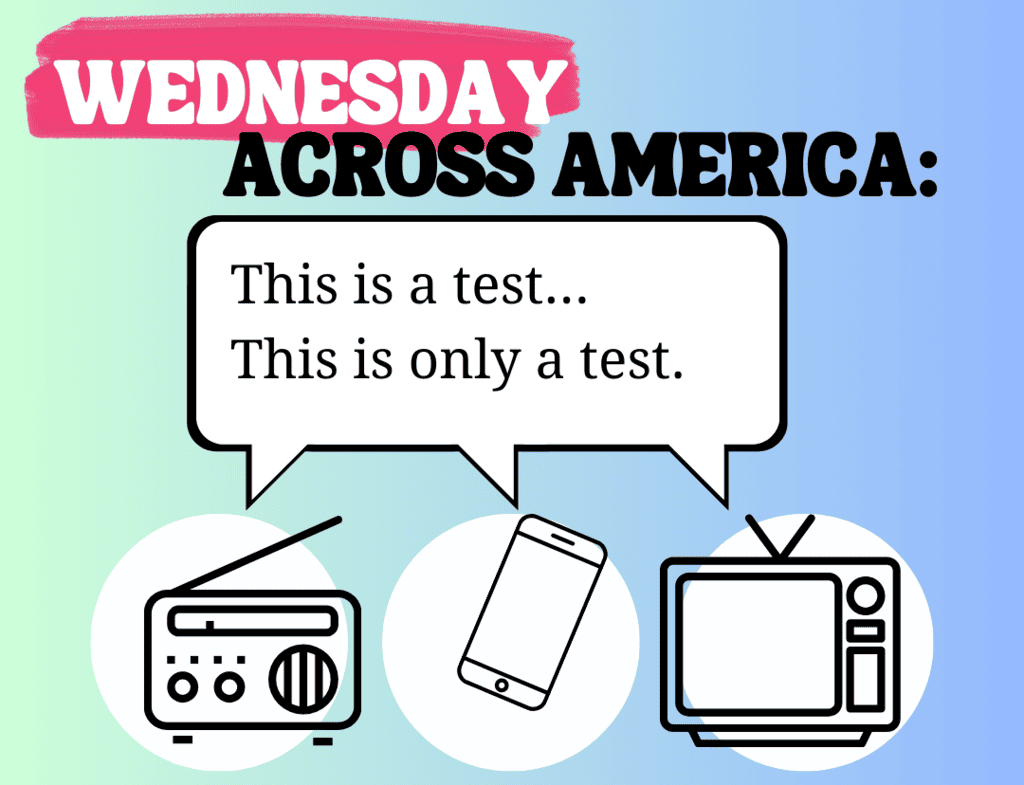We usually get a local test at noon Wednesdays of our emergency sirens, but something else if happening this Wednesday… Nationwide, all electronic devices are going to sound off with an emergency alert test. This will happen on Wednesday, October 4, 2023.
On that day, the Federal Emergency Management Agency (FEMA) and the Federal Communications Commission (FCC) will conduct a nationwide test of the Emergency Alert System (EAS) and Wireless Emergency Alerts (WEA) across every device in the U.S., including TVs, radios, and cellphones.
WHEN
The nationwide alert is scheduled for approximately 1:20 p.m. Central Time. It will last around 30 minutes. During this time, Americans will receive an emergency alert on their devices.
READ MORE BELOW ??
RADIO & TV
The EAS portion of the test will be sent to radios and televisions. This will be the 7th nationwide EAS test. Here’s what to expect with the EAS test:
- It’s scheduled to last approximately one minute.
- It will be on radio – AM, FM & satellite stations
- It will be on TV – antenna, cable, satellite, streaming and wireline.
- The test message will be similar to the regular monthly EAS test messages with which the public is familiar. It will state: “This is a nationwide test of the Emergency Alert System, issued by the Federal Emergency Management Agency, covering the United States from 14:20 to 14:50 hours ET. This is only a test. No action is required by the public.
READ MORE BELOW ??
CELL PHONES
The WEA portion of the test will be on all consumer cell phones. This will be the 3rd nationwide test, but the 2nd test to all cellular devices. The last test like this was in 2021. The test message will display in either English or in Spanish, depending on the language settings of the wireless handset.
This test will be initiated using FEMA’s Integrated Public Alert and Warning System (IPAWS), a centralized internet-based system administered by FEMA that enables authorities to send authenticated emergency messages to the public through multiple communications networks. The WEA test will be administered via a code sent to cell phones.
The message that cell phones will receive will be similar to this: “This is a nationwide test of the Emergency Alert System, issued by the Federal Emergency Management Agency, covering the United States from 14:20 to 14:50 hours ET. This is only a test. No action is required by the public.”
This year the EAS message will be disseminated as a Common Alerting Protocol (CAP) message via the Integrated Public Alert and Warning System-Open Platform for Emergency Networks (IPAWS-OPEN).
All wireless phones should receive the message only once. Here’s what to expect:
- Beginning at approximately 2:20 p.m. ET, cell towers will broadcast the test for approximately 30 minutes. During this time, WEA-compatible wireless phones that are switched on, within range of an active cell tower, and whose wireless provider participates in WEA, should be capable of receiving the test message.
- For consumers, the message that appears on their phones will read: “THIS IS A TEST of the National Wireless Emergency Alert System. No action is needed.”
- Phones with the main menu set to Spanish will display: “ESTA ES UNA PRUEBA del Sistema Nacional de Alerta de Emergencia. No se necesita acción.”
WEA alerts are created and sent by authorized federal, state, local, tribal and territorial government agencies through IPAWS to participating wireless providers, which deliver the alerts to compatible handsets in geo-targeted areas. To help ensure that these alerts are accessible to the entire public, including people with disabilities, the alerts are accompanied by a unique tone and vibration.
WHY
The purpose of the October 4 test is to ensure that the systems continue to be effective means of warning the public about emergencies, particularly those on the national level. If there is widespread severe weather on that day, the test will be postponed to the back-up testing date of October 11.
THIS IS ONLY A TEST
It’s important to note that this is just a test, and no action is required. FEMA is conducting the test to ensure that both the EAS and WEA are functioning properly in case of a potential national disaster or attack.





